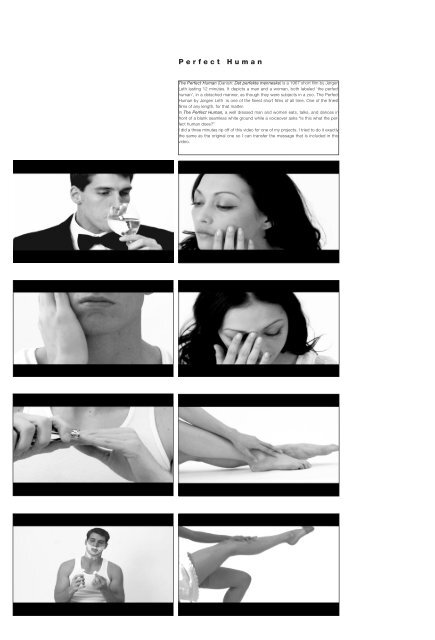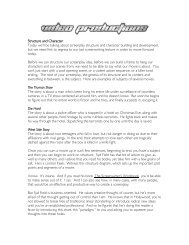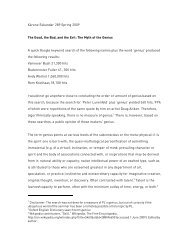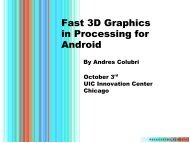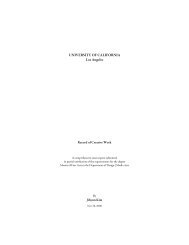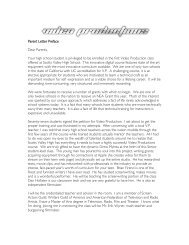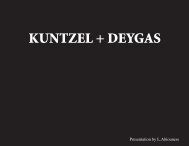Perfect Human - Users
Perfect Human - Users
Perfect Human - Users
- No tags were found...
You also want an ePaper? Increase the reach of your titles
YUMPU automatically turns print PDFs into web optimized ePapers that Google loves.
<strong>Perfect</strong> <strong>Human</strong>The <strong>Perfect</strong> <strong>Human</strong> (Danish: Det perfekte menneske) is a 1967 short film by JørgenLeth lasting 12 minutes. It depicts a man and a woman, both labeled ‘the perfecthuman’, in a detached manner, as though they were subjects in a zoo. The <strong>Perfect</strong><strong>Human</strong> by Jørgen Leth is one of the finest short films of all time. One of the finestfilms of any length, for that matter.In The <strong>Perfect</strong> <strong>Human</strong>, a well dressed man and women eats, talks, and dances infront of a blank seamless white ground while a voiceover asks “Is this what the perfecthuman does?”I did a three minutes rip off of this video for one of my projects. I tried to do it exactlythe same as the original one so I can transfer the message that is included in thisvideo.
<strong>Perfect</strong> <strong>Human</strong>The <strong>Perfect</strong> <strong>Human</strong> (Danish: Det perfekte menneske) is a 1967 short film by JørgenLeth lasting 12 minutes. It depicts a man and a woman, both labeled ‘the perfecthuman’, in a detached manner, as though they were subjects in a zoo. The <strong>Perfect</strong><strong>Human</strong> by Jørgen Leth is one of the finest short films of all time. One of the finestfilms of any length, for that matter.In The <strong>Perfect</strong> <strong>Human</strong>, a well dressed man and women eats, talks, and dances infront of a blank seamless white ground while a voiceover asks “Is this what the perfecthuman does?”I did a three minutes rip off of this video for one of my projects. I tried to do it exactlythe same as the original one so I can transfer the message that is included in thisvideo.
<strong>Perfect</strong> <strong>Human</strong>The <strong>Perfect</strong> <strong>Human</strong> (Danish: Det perfekte menneske) is a 1967 short film by JørgenLeth lasting 12 minutes. It depicts a man and a woman, both labeled ‘the perfecthuman’, in a detached manner, as though they were subjects in a zoo. The <strong>Perfect</strong><strong>Human</strong> by Jørgen Leth is one of the finest short films of all time. One of the finestfilms of any length, for that matter.In The <strong>Perfect</strong> <strong>Human</strong>, a well dressed man and women eats, talks, and dances infront of a blank seamless white ground while a voiceover asks “Is this what the perfecthuman does?”I did a three minutes rip off of this video for one of my projects. I tried to do it exactlythe same as the original one so I can transfer the message that is included in thisvideo.
<strong>Perfect</strong> <strong>Human</strong>The <strong>Perfect</strong> <strong>Human</strong> (Danish: Det perfektemenneske) is a 1967 short film by JørgenLeth lasting 12 minutes. It depicts a manand a woman, both labeled ‘the perfect human’,in a detached manner, as though theywere subjects in a zoo. The <strong>Perfect</strong> <strong>Human</strong>by Jørgen Leth is one of the finest shortfilms of all time. One of the finest films ofany length, for that matter.In The <strong>Perfect</strong> <strong>Human</strong>, a well dressed manand women eats, talks, and dances in frontof a blank seamless white ground while avoiceover asks “Is this what the perfect humandoes?”I did a three minutes rip off of this video forone of my projects. I tried to do it exactly thesame as the original one so I can transferthe message that is included in this video.
<strong>Perfect</strong> <strong>Human</strong>The <strong>Perfect</strong> <strong>Human</strong> (Danish: Det perfekte menneske) is a 1967 short film by JørgenLeth lasting twelve minutes. It depicts a man and a woman, both labeled ‘the perfecthuman’, in a detached manner, as though they were subjects in a zoo. The <strong>Perfect</strong><strong>Human</strong> by Jørgen Leth is one of the finest short films of all time. One of the finest filmsof any length, for that matter.In The <strong>Perfect</strong> <strong>Human</strong>, a well dressed man and women eats, talks, and dances in frontof a blank seamless white ground while a voiceover asks “Is this what the perfecthuman does?”I created a three minutes version of this video focusing mostly on the main sceneswhile keeping the lighting, video angles and clothing the same. I believed by doing soeven the short version could portray the original message in this movie.
REDDifferent Colors instigate different feelings. This project required the use of color red in a shortten seconds movie. For me red means love and passion and I expressed these emotions byhaving a women sitting on a park bench and picking on red daisy flower and asking herselfan endless question. “He loves me, he loves me not” only to find out there are many othersimilar Daisy flowers by her side. The question continues...
CLOSERThe <strong>Perfect</strong> <strong>Human</strong> (Danish: Det perfekte menneske) is a 1967 short film byJørgen Leth lasting 12 minutes. It depicts a man and a woman, both labeled ‘theperfect human’, in a detached manner, as though they were subjects in a zoo. The<strong>Perfect</strong> <strong>Human</strong> by Jørgen Leth is one of the finest short films of all time. One ofthe finest films of any length, for that matter.In The <strong>Perfect</strong> <strong>Human</strong>, a well dressed man and women eats, talks, and dancesin front of a blank seamless white ground while a voiceover asks “Is this what theperfect human does?”I did a three minutes rip off of this video for one of my projects. I tried to do it exactlythe same as the original one so I can transfer the message that is includedin this video.Spiky political questions lend research into wearable computinglayers of shadow and darkness to throw into relief the sensethat whisper[s] was a pretty project, conceived by women artistswith histories in dance, who want to create a way for peopleto touch each other, but only to play in the pleasurable or gentlyerotic region of the sensory spectrum. It cannot be assumedthat a project that seems to be beautiful is without abjection orcorporeal, aesthetic, and political controversy. So much politicalcontrol is enacted upon bodies. So much Western consumerismis directed at bodies. And, as computers become mobileand miniaturized, they are less directed at offices and minds,but are pointed at bodies, dangled in front of us until we thirst totouch the latest mobile phone or for the look and performance ofthe newest generation iPod or gaming console. It is known thatbodies are the site of colonization, and the site of resistance. Itis also known that bodies are the sites of difference and diversity,of pain and pleasure. What remains underexplored is theextent to which performative acts of sharing the body throughour digital devices may allow us to construct collaboratively newphysical states or states of conscious awareness. Is this fluffygirl art? Perhaps, but there might be claws and teeth beneathClosingthe fluff, or just a creeping sense of unease combined with analternative political agenda. Of course, women artists and researchers are by no means theonly ones to emphasize corporeality, performance, introspection,affect, softness, beauty, intimacy, touch, play, textiles,movement, flirtation, or ambiguity of meaning in the contextof technologies. And, of course, the objectives of physical orperformative computing are not just the creation of sensory orsensual experiences. What we construct with our digital devicesare identities and differences. These flow beyond the momentof exchange with the digital data and are carried with us.The body has an extraordinary capacity to retain traces, andknowledge and actions are shaped in part by these traces.The research and performance emerging from all of the systemsin this book—telematics, responsive architectures,motion capture, and wearables—reveal that, just like in life,relationships unfold in diverse directions: toward banality, detachment,control, play, generosity, secrecy, hesitation, exuberance.Revealing and becoming are not static states; theymorph, and embodiment brings forth, or reveals, the manysubtle transitions of daily life. Each of these computationalsystems is extraordinarily rich for performance research preciselybecause they can let emerge latencies within us, levelsof intuition and affect, that animate us as human beings. Themethodologies of phenomenology and performance help toenhance these latencies. With careful—even sensitive—design,future generations of these systems and devices canexpand our social, physical, and emotional exchanges.Perhaps, in the end, the title of this book, Closer, is less areflection of Merleau-Ponty’s philosophy than it is of Joy Division’salbum of 1980 by the same name. The entwinementbetween beauty and abjection are immortalized by Ian Curtis’swords: “love, love will tear us apart…again.”


